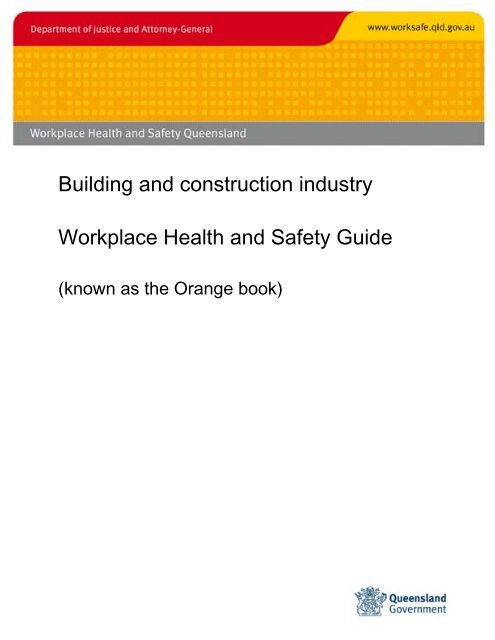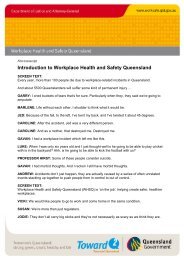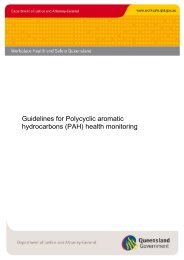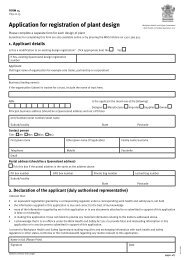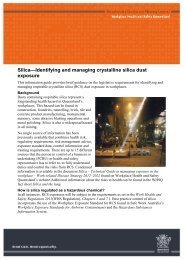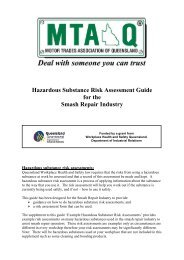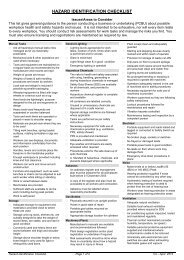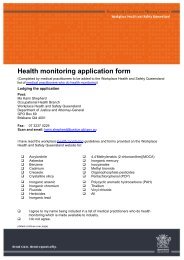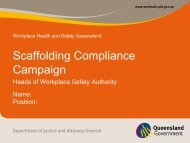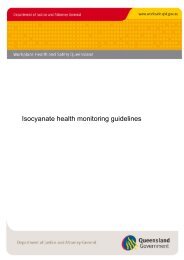Building and construction guide - Queensland Government
Building and construction guide - Queensland Government
Building and construction guide - Queensland Government
Create successful ePaper yourself
Turn your PDF publications into a flip-book with our unique Google optimized e-Paper software.
<strong>Building</strong> <strong>and</strong> <strong>construction</strong> industryWorkplace Health <strong>and</strong> Safety Guide(known as the Orange book)
© The State of Queensl<strong>and</strong> (Department of Justice <strong>and</strong> Attorney-General) 2011Copyright protects this document. The State of Queensl<strong>and</strong> has no objection to this material being reproduced, but asserts its right to be recognised asauthor of the original material <strong>and</strong> the right to have the material unaltered.The material presented in this publication is distributed by the Queensl<strong>and</strong> <strong>Government</strong> as an information source only. The State of Queensl<strong>and</strong> makesno statements, representations, or warranties about the accuracy or completeness of the information contained in this publication, <strong>and</strong> the readershould not rely on it. The Queensl<strong>and</strong> <strong>Government</strong> disclaims all responsibility <strong>and</strong> all liability (including, without limitation, liability in negligence) for allexpenses, losses, damages <strong>and</strong> costs you might incur as a result of the information being inaccurate or incomplete in any way, <strong>and</strong> for any reason.Workplace Health <strong>and</strong> Safety Queensl<strong>and</strong>, Department of Justice <strong>and</strong> Attorney-GeneralH<strong>and</strong>book <strong>Building</strong> <strong>and</strong> <strong>construction</strong> industry Workplace Health <strong>and</strong> Safety GuidePN10129 Version 3 Last updated May 20111
Contents<strong>Building</strong> <strong>and</strong> <strong>construction</strong> industry................................................................................................. 3Definitions....................................................................................................................................... 3Construction safety plans................................................................................................................ 5Work method statements................................................................................................................. 5General induction............................................................................................................................ 7Site-specific induction .................................................................................................................... 7Signage............................................................................................................................................ 7Safe housekeeping practices ........................................................................................................... 8Common plant................................................................................................................................. 8Underground services ..................................................................................................................... 9Excavations..................................................................................................................................... 9Work at heights............................................................................................................................. 10Single or extension ladders ........................................................................................................... 10Trestle ladder platforms ................................................................................................................ 11Erecting <strong>and</strong> dismantling scaffolding ........................................................................................... 12Falling objects............................................................................................................................... 12Amenities ...................................................................................................................................... 13Other hazards ................................................................................................................................ 14More information.......................................................................................................................... 14Workplace Health <strong>and</strong> Safety Queensl<strong>and</strong>, Department of Justice <strong>and</strong> Attorney-GeneralH<strong>and</strong>book <strong>Building</strong> <strong>and</strong> <strong>construction</strong> industry Workplace Health <strong>and</strong> Safety GuidePN10129 Version 3 Last updated May 20112
<strong>Building</strong> <strong>and</strong> <strong>construction</strong> industryWorking in the building <strong>and</strong> <strong>construction</strong> industry is a risky business. Contractors,subcontractors <strong>and</strong> their workers face risks from hazards that must be managed to prevent deaths,injuries <strong>and</strong> illness.The Workplace Health <strong>and</strong> Safety Regulation 2008 clearly states the way workplace health <strong>and</strong>safety risks from certain hazards must be managed. The regulations cover:• principal contractor <strong>construction</strong> safety plans• work method statements for high-risk <strong>construction</strong> activities, demolition work <strong>and</strong> asbestosremoval• general <strong>and</strong> site-specific induction• housekeeping practices• safety of plant provided for common use• excavations (including trenches)• working at heights (including work on roofs, from ladders <strong>and</strong> trestle ladder platforms, <strong>and</strong>work to erect or dismantle scaffolding)• protecting the public <strong>and</strong> workers from falling objects• amenities.On-the-spot fines are attached to the regulations. The amount of fines reflects the severity of thebreach.DefinitionsWhat is <strong>construction</strong> work?Work is <strong>construction</strong> work if it is:(a) work to erect, construct, extend, alter, convert, fit-out, commission, renovate, repair,refurbish, disassemble or decommission a structure, or part of a structure; or(b) work connected with site preparation, excavation <strong>and</strong> l<strong>and</strong>scaping for work mentioned inparagraph (a); or(c) the assembly or installation of prefabricated components to form a structure, or part of astructure, for work mentioned in paragraph (a); or(d) the disassembly of prefabricated components for work mentioned in paragraph (a) that,immediately before the disassembly, formed a structure or part of a structure; or(e) an activity that is a prescribed activity.What is a structure?Structure means:(a) a building, <strong>construction</strong>, wall, mast, tower, pylon, structural cable or telecommunicationsstructure; or(b) an underground works (including shafts <strong>and</strong> tunnels), pipe, pipeline, sea defence works, riverworks, earthworks or earth retaining <strong>construction</strong> or other <strong>construction</strong> designed to preserveor alter a natural feature; orWorkplace Health <strong>and</strong> Safety Queensl<strong>and</strong>, Department of Justice <strong>and</strong> Attorney-GeneralH<strong>and</strong>book <strong>Building</strong> <strong>and</strong> <strong>construction</strong> industry Workplace Health <strong>and</strong> Safety GuidePN10129 Version 3 Last updated May 20113
(c) a road or highway, footpath or driveway, railway line or siding, tramway line, airfield, dockor harbour, water storage or supply system (including a constructed lagoon), sewerage ordrainage system, electricity or gas generation facility, transmission or distribution facility,gasholder, park or recreation ground (including, for example, a golf course, playing field,racecourse or swimming pool); or(d) production, storage or distribution facilities for heavy industries; or(e) fixed plant; or(f) a ship or submarine; or(g) formwork, falsework, scaffold or other <strong>construction</strong> designed or used to provide support,access or containment during <strong>construction</strong> work.Civil <strong>construction</strong> work – <strong>construction</strong> of roads, highways, railways, harbours, water storage orsupply systems, sewerage or drainage systems, electricity or gas generation, transmission ordistribution structures, parks or recreational grounds, production, storage <strong>and</strong> distributionfacilities for heavy industry, refineries, pumping stations or mines <strong>and</strong> the <strong>construction</strong> orstructural alteration of bridges <strong>and</strong> the erection of telecommunications structures.Demolition work – demolition or systematic dismantling of a building or other structure, or partof a building or other structure, not including the systematic dismantling of a part of a building orother structure for alteration, maintenance, remodelling or repair.Housing <strong>construction</strong> work - work to erect, construct, extend or structurally alter:(a) any of the following dwellings that is not located above or below another dwelling oranother part of a building, other than a private garage:(i)(ii)a detached house;an attached dwelling, separated from the dwelling to which it is attached by a fireresistingwall, for example, a terrace house or town house;(iii) a boarding house, guest house, hostel or similar building with a floor area of not morethan 300m2; or(b) a building that is not designed for habitation but is ancillary to one of the above.Principal contractor for <strong>construction</strong> work(1) The principal contractor for <strong>construction</strong> work, other than prescribed <strong>construction</strong> work, isthe person appointed by the client as the principal contractor for the <strong>construction</strong> work undersection 184A.(2) If the client does not appoint a principal contractor for the <strong>construction</strong> work, the client istaken to be the principal contractor for the <strong>construction</strong> work.(3) The principal contractor for prescribed <strong>construction</strong> work is the person who is in control ofthe prescribed <strong>construction</strong> work.Note—For <strong>construction</strong> work for which there is no client <strong>and</strong> that is not prescribed <strong>construction</strong> work, there is no principalcontractor.Relevant person - A person who conducts a business or undertaking has an obligation to ensurethe workplace health <strong>and</strong> safety of the person, each of the person’s workers <strong>and</strong> any otherpersons is not affected by the conduct of the relevant person’s business or undertaking.Workplace Health <strong>and</strong> Safety Queensl<strong>and</strong>, Department of Justice <strong>and</strong> Attorney-GeneralH<strong>and</strong>book <strong>Building</strong> <strong>and</strong> <strong>construction</strong> industry Workplace Health <strong>and</strong> Safety GuidePN10129 Version 3 Last updated May 20114
Construction safety plansA documented plan for the <strong>construction</strong> work can assist the principal contractor to managerelevant workplace health <strong>and</strong> safety obligations.A principal contractor must prepare a <strong>construction</strong> safety plan before <strong>construction</strong> work starts.The plan must state:• workplace address• name <strong>and</strong> address of the principal contractor• principal contractor’s ABN• whether there is a WHS committee• whether there is a WHSO appointed• expected start date• estimated duration of the work• type of <strong>construction</strong>• common plant to be provided• site rules• the risks the principal contractor is obligated to manage• proposed control measures for the risks• how the controls will be implemented• arrangements for monitoring <strong>and</strong> reviewing controls• emergency procedures, <strong>and</strong>• public safety strategies.The plan must be:• written so it is easy to underst<strong>and</strong>• signed <strong>and</strong> dated by the principal contractor• available for the length of the project.The principal contractor must sign <strong>and</strong> date work method statements that have been received <strong>and</strong>keep them with the plan, as well as monitor their implementation.The principal contractor cannot allow work to start unless the plan:• has been discussed with or a copy given to all relevant persons employers <strong>and</strong> self-employedpersons• is available or readily available for inspection.The plan must be amended if there are changes in how risks will be managed. The principalcontractor must inform any affected person of the change.Work method statementsWork method statements assist a subcontractor to consider how certain activities will be carriedout safely.Workplace Health <strong>and</strong> Safety Queensl<strong>and</strong>, Department of Justice <strong>and</strong> Attorney-GeneralH<strong>and</strong>book <strong>Building</strong> <strong>and</strong> <strong>construction</strong> industry Workplace Health <strong>and</strong> Safety GuidePN10129 Version 3 Last updated May 20115
A subcontractor doing <strong>construction</strong> work needs to prepare a work method statement for thesehigh-risk activities:(a) where a person is:(i) required to enter a trench more than 1.5 metres deep;(ii) using explosives other than powder-actuated h<strong>and</strong>held fastening tools;(iii) using a confined space; or(iv) using a hazardous substance.(b) if a person could fall:(i) at least 3 metres for housing <strong>construction</strong>; or(ii) at least 2 metres for other <strong>construction</strong>.(c) working on a roof surface or partly completed roof surface, with a slope greater than 26°(d) the activity is:(i) a prescribed activity (i.e. demolition work as defined in the Workplace Health <strong>and</strong>Safety Act 1995 or work to remove friable asbestos containing material); or(ii) demolition work that is not a prescribed activity.(e) the activity consists of:(i) tilt-up <strong>and</strong> precast <strong>construction</strong> work; or(ii) structural alterations that require temporary support to prevent collapse; or(iii) the movement of powered mobile plant at the workplace; or(iv) work on a telecommunications tower; or(v) work in, over or adjacent to water if there is a risk of drowning; or(vi) work on, or adjacent to, a road or railway; or(vii) work on or near a pressurised gas distribution mains <strong>and</strong> consumer piping; or(viii) work on or near a chemical, fuel or refrigerant line; or(ix) work near an exposed energised electrical installation; or(x) work in an area that may have a contaminated or flammable atmosphere; or(xi) work in an area where there are artificial extremes of temperature.(f) The principal contractor for the <strong>construction</strong> work reasonably believes the activity couldresult in death or bodily harm.The work method statement must take into account the principal contractor’s <strong>construction</strong> safetyplan <strong>and</strong> also state:(a) the high-risk <strong>construction</strong> activity; <strong>and</strong>(b) the person’s ABN; <strong>and</strong>(c) the control measures to be used; <strong>and</strong>(d) the way the activity will be performed; <strong>and</strong>(e) how the control measures will be monitored <strong>and</strong> reviewed; <strong>and</strong>(f) licences for high risk work <strong>and</strong> earthmoving or particular crane occupations.Work method statements must be easy to underst<strong>and</strong>, signed <strong>and</strong> dated.6 7The work method statement must be amended if there is a change in the activity <strong>and</strong> a copygiven to the principal contractor. All persons affected by changes must be advised ofamendments to the work method statement.Workplace Health <strong>and</strong> Safety Queensl<strong>and</strong>, Department of Justice <strong>and</strong> Attorney-GeneralH<strong>and</strong>book <strong>Building</strong> <strong>and</strong> <strong>construction</strong> industry Workplace Health <strong>and</strong> Safety GuidePN10129 Version 3 Last updated May 20116
The work method statement must be readily available for inspection. It must also be reviewedeach year <strong>and</strong> amended if necessary.General inductionAll persons undertaking <strong>construction</strong> work must hold general induction evidence before the workstarts. General induction provides an opportunity for people working in the industry to gain someunderst<strong>and</strong>ing of the types of hazards likely to be found on <strong>construction</strong> sites <strong>and</strong> the way risksfrom these hazards should be managed.General induction evidence means:• A valid statement of attainment or <strong>construction</strong> induction card issued by a RegisteredTraining Organisation for successfully completing a registered course.Note: As of 1 July 2009, the current general induction unit of competency is CPCCOHS1001A.For more information on organisations approved to deliver the course, telephone 1300 369 915,or visit the website www.worksafe.qld.gov.au for a complete list.Site-specific inductionHaving systems in place at the workplace to ensure people are aware of the specific procedures<strong>and</strong> rules for the site will help minimise the risk of death, injury or illness.While site-specific induction is not necessary for workplaces where housing <strong>construction</strong> work isbeing carried out, it is important nonetheless for the contents of the principal contractor’s<strong>construction</strong> safety plan to be communicated effectively where site-specific induction is notgiven.A principal contractor must ensure a person has had a site-specific induction before that personstarts <strong>construction</strong> work.The principal contractor must ensure a person entering a part of the workplace where<strong>construction</strong> work is being done:(a) has been given a site-specific induction; or(b) is accompanied by the principal contractor or someone who has been given a site-specificinduction.The induction needs to address the contents of the <strong>construction</strong> safety plan, including site rules.The principal contractor must make a record of the people inducted <strong>and</strong> the date it was given.The record must be kept for the duration of the <strong>construction</strong> work.8 9SignageWorkplace Health <strong>and</strong> Safety Queensl<strong>and</strong>, Department of Justice <strong>and</strong> Attorney-GeneralH<strong>and</strong>book <strong>Building</strong> <strong>and</strong> <strong>construction</strong> industry Workplace Health <strong>and</strong> Safety GuidePN10129 Version 3 Last updated May 20117
The principal contractor must, before <strong>construction</strong> work starts, ensure that adequate numbers ofgeneral safety signs, having regard to the size <strong>and</strong> complexity of the workplace, are erected.Appropriate signs may include signs about:• the nature of the workplace• the direction to the site office or site amenities• where first aid <strong>and</strong> fire extinguishing equipment is kept• the means of access to be kept clear• where hazardous substances are kept• who the principal contractor is• head <strong>and</strong> foot protection to be worn• authorisations required for the site.The principal contractor must keep the signs in good condition.Safe housekeeping practicesPrincipal contractors play an important role in ensuring the orderly conduct of a <strong>construction</strong>workplace.The principal contractor must ensure safe housekeeping practices including:• appropriate, safe <strong>and</strong> clear access to <strong>and</strong> from the workplace• safe systems for collecting, storing <strong>and</strong> disposing of excess or waste materials• adequate space for storing materials or plant.A subcontractor must implement <strong>and</strong> maintain the safe housekeeping practices that apply to theirwork including:• managing risks from protruding objects such as exposed nails or vertical reinforcing steel• providing <strong>and</strong> maintaining appropriate lighting for the work being done.Subcontractors must ensure their workers on site are instructed to follow the safe housekeepingpractices.Common plantCommon plant is plant provided by the principal contractor for use by another person at theworkplace, e.g. scaffolding, switchboards.A principal contractor must ensure common plant is safe for the purpose for which it is provided<strong>and</strong> that it is maintained.The principal contractor must comply with any requirements about the plant in Part 20 of theWorkplace Health <strong>and</strong> Safety Regulation 2008. A subcontractor or worker using the plant mustensure all requirements about its safe use are complied with.Workplace Health <strong>and</strong> Safety Queensl<strong>and</strong>, Department of Justice <strong>and</strong> Attorney-GeneralH<strong>and</strong>book <strong>Building</strong> <strong>and</strong> <strong>construction</strong> industry Workplace Health <strong>and</strong> Safety GuidePN10129 Version 3 Last updated May 20118
Underground servicesBefore excavation work starts, if there is a principal contractor appointed, or if no principalcontractor has been appointed then each relevant subcontractor must:(a) find out what underground services exist at or near the location of the excavation(b) obtain relevant information about the service (location, type, depth, restrictions to befollowed) from the appropriate source(c) record the information in writing(d) keep the information recorded until the <strong>construction</strong> work ends.Dial 1100 Before You Dig is a useful service.Ensure this information is considered in planning the work <strong>and</strong> decide on <strong>and</strong> use controlmeasures to prevent people being exposed to the risk of death, illness or injury from coming incontact with, or damage to, the service.Excavations(including trenches)A relevant subcontractor must manage the risks associated with:• an excavation collapsing• objects falling into an excavation• a person falling into an excavation,• a person being exposed to carbon monoxide or other impurity of the air in the excavation.A relevant subcontractor must decide on <strong>and</strong> use appropriate control measures <strong>and</strong> maintain thecontrol measures necessary to prevent, or minimise the level of, exposure to the risk.A relevant subcontractor must implement any control measures necessary to prevent risk fromthe collapse of another structure such as an adjoining building or road.A barricade or hoarding at least 900 mm must be erected around an excavation unless it isimpracticable or no person is likely to be in the vicinity of the excavation.The relevant subcontractor must erect a barricade at least 900 mm high around a trench unless itis impracticable, or only workers involved with the trench will be in the area; or another form ofbarrier exists, e.g. excavated materials near the trench.A relevant subcontractor needs to ensure that if a person is entering a trench more than 1.5metres deep, one of the following control measures is implemented:(a) has shoring or shielding; or(b) is benched – not higher than it is wide <strong>and</strong> no vertical face exceeding 1.5 metres; or(c) is battered – angle not exceeding 45° <strong>and</strong> bottom vertical face not exceeding 1.5 metres; or(d) is approved in writing by an geo-technical engineer as safe to work in.Workplace Health <strong>and</strong> Safety Queensl<strong>and</strong>, Department of Justice <strong>and</strong> Attorney-GeneralH<strong>and</strong>book <strong>Building</strong> <strong>and</strong> <strong>construction</strong> industry Workplace Health <strong>and</strong> Safety GuidePN10129 Version 3 Last updated May 20119
A geo-technical engineer must provide written approval to vary the benching <strong>and</strong> batteringrequirements. The approval must be kept on site at all times.Ladders used for access must be no more than nine metres apart in the area of the trench wherework will be carried out.Work at heights(excluding work on ladders or trestle ladder platforms <strong>and</strong> scaffolding work)If there is a risk of fall of less than three metres in housing <strong>construction</strong> work or less than twometres in other <strong>construction</strong> work, or if work is on a roof surface or partly completed roofsurface, with a slope not over 26°, the subcontractor who intends to do the work must identifyeach hazard <strong>and</strong> assess the risk as a result of the hazard before work starts.Hazards that may present a risk from a fall include:• vertical reinforcing steel, the edge of a rubbish skip, a picket fence, or a stack of bricksbelow workers• unsheeted floor bearers <strong>and</strong> joists two metres below workers• work on a brittle roof two metres above a floor.12 13Factors such as the type of activity being carried out should be taken into consideration toestablish the degree of risk.Control measures used to manage risks must comply with regulatory requirements.A subcontractor carrying out work above these heights, or on a roof surface or partly completedroof surface, with a slope over 26° must:• prevent a fall; or• if prevention is not practicable, arrest the fall <strong>and</strong> prevent or minimise the risk of death orinjury from the arrest of the fall.The controls could include:• edge protection• fall protection cover (includes an enclosed environment)• fall arresting platform• travel restraint system• fall-arrest harness system; or• industrial safety net.Refer to Part 20 of the Workplace Health <strong>and</strong> Safety Regulation 2008 for the specificrequirements for these controls.Single or extension laddersSingle or extension ladders may only be used to:Workplace Health <strong>and</strong> Safety Queensl<strong>and</strong>, Department of Justice <strong>and</strong> Attorney-GeneralH<strong>and</strong>book <strong>Building</strong> <strong>and</strong> <strong>construction</strong> industry Workplace Health <strong>and</strong> Safety GuidePN10129 Version 3 Last updated May 201110
(a) gain access; or(b) carry out permitted work – where the material or equipment being carried does not restrictmovement or cause loss of balance;(c) the trunk of the body remains centred on the ladder; <strong>and</strong>(d) equipment can be used with one h<strong>and</strong> (unless a control to prevent a fall is used).A person using a ladder for access or permitted work must either:(a) have three points of substantial contact with the ladder or a stable object, e.g. st<strong>and</strong>ing on theladder with two feet while holding a fascia board or timber stud(b) prevent falls with a control measure, e.g. a pole strap; or(c) use a fall-arrest harness system (not attached to the ladder).The ladder must have a load rating of not less than 120 kg <strong>and</strong> be:(a) secured against movement at or near its top or bottom, e.g. by tying or clamping;(b) manufactured for industrial use;(c) used only for the designed purpose;(d) not more than 6.1 metres for a single ladder;(e) not more than 9.2 metres for an extension ladder used for electrical work or 7.5 metres forother work;(f) on a firm <strong>and</strong> stable surface;(g) placed at an angle between 70° <strong>and</strong> 80°; <strong>and</strong>(h) extended at least one metre above a surface being accessed.Trestle ladder platformsPlatforms used on trestle ladders below three metres for housing <strong>construction</strong> or two metres forother <strong>construction</strong> work must be 450 mm wide unless the work is light work.Examples of light work include:• painting, installing a roof gutter, air-conditioning duct, metal fascia or lighting• placing pine roof trusses in position• performing inspections or tests• installing an electrical connection.Fixing plasterboard sheeting to an internal stairwell void, fixing cladding to a gable end of a roofor using a medium or heavy duty angle grinder or circular saw are not considered light work.For work on a trestle ladder at three metres or more for housing <strong>construction</strong> work or two metresor more for other <strong>construction</strong> work:• the trestle ladder must have edge protection along the outer length of the platform• control measures must be put in place where:− there is a risk of a person falling off the edge of each end of the platform, or− the gap between the inner edge of the platform <strong>and</strong> the face of a building/structure isgreater than 225 mmWorkplace Health <strong>and</strong> Safety Queensl<strong>and</strong>, Department of Justice <strong>and</strong> Attorney-GeneralH<strong>and</strong>book <strong>Building</strong> <strong>and</strong> <strong>construction</strong> industry Workplace Health <strong>and</strong> Safety GuidePN10129 Version 3 Last updated May 201111
• each trestle ladder must be secured to prevent it moving, e.g. tying the ladder to a sturdy wallor bracing it to the ground• the platform must have an unobstructed surface width of 450 mm; <strong>and</strong>• be not higher than five metres.Erecting <strong>and</strong> dismantling scaffoldingA person erecting or dismantling scaffolding three metres or more in housing <strong>construction</strong> workor two metres or more in other <strong>construction</strong> work must:• be prevented from falling• use a fall-arrest harness system; or• immediately install platforms, edge protection <strong>and</strong> a means of access as each level is erected;<strong>and</strong>• retain a full deck of platform until the platforms are transferred.Falling objectsA principal contractor must ensure appropriate control measures are used to prevent, or minimisethe level of, exposure to the risk of falling objects on the <strong>construction</strong> site <strong>and</strong> onto adjoiningareas such as a public footpath, road, square or the yard of a dwelling or other building beside aworkplace.Housing <strong>and</strong> civil <strong>construction</strong> workA principal contractor or subcontractor must assess the risk from falling objects <strong>and</strong> use controlsto prevent or minimise the risks from falling objects. The controls chosen must comply with anyregulatory requirements.Construction work other than housing or civilA principal contractor or subcontractor must implement one of the following controls based onthe angle between the highest point where work is to be carried out <strong>and</strong> the line where the controlwill be put:• barricade or hoarding at least 900 mm high ≤ 15°• hoarding at least 1800 mm high > 15° <strong>and</strong> ≤ 30°• fully sheeted hoarding at least 1800 mm high > 30°, <strong>and</strong>• if the angle is equal to or more than 75° <strong>and</strong> not demolition work or work erecting ordismantling formwork:− erect a gantry; close the adjoining area, or− erect a catch platform with vertical sheeting, or− perimeter screening.The principal contractor or subcontractor must close the adjoining area or erect perimetercontainment screening where demolition work or work erecting or dismantling formwork isbeing carried out.Workplace Health <strong>and</strong> Safety Queensl<strong>and</strong>, Department of Justice <strong>and</strong> Attorney-GeneralH<strong>and</strong>book <strong>Building</strong> <strong>and</strong> <strong>construction</strong> industry Workplace Health <strong>and</strong> Safety GuidePN10129 Version 3 Last updated May 201112
However, if permission to close the adjoining area is withheld <strong>and</strong> perimeter containmentscreening cannot be erected, the principal contractor or subcontractor must ensure that anothercontrol measure is implemented to prevent objects falling on or otherwise hitting members of thepublic.The public must be kept out of an adjoining area where loads are being lifted, unless a gantry,that would withst<strong>and</strong> the force of the load if it fell, has been provided.Refer to Part 20 of the Workplace Health <strong>and</strong> Safety Regulation 2008 for specific requirementson control measures for protecting persons from falling objects.AmenitiesA principal contractor must ensure workers have reasonable access to a room or sheltered area toeat meals or take breaks. The area must:• present no health or safety risk• be hygienic• have adequate space, seating <strong>and</strong> facilities for washing <strong>and</strong> storing utensils, boiling water<strong>and</strong> storing food in a cool place if there are 15 or more workers at the site.Principal contractors must ensure workers have reasonable access to toilets. Reasonable accessfor a civil <strong>construction</strong> workplace would be a toilet in the workplace site compound boundaries<strong>and</strong> for other <strong>construction</strong> workplaces, within the workplace site boundaries.There must be one toilet available for each 15, or part number of workers. A toilet connected tosewerage, a septic system, a pump-out holding tank storage type system (‘connected’) or aportable toilet is acceptable for a workplace with fewer than 15 workers. However, if the numberof the workers increases <strong>and</strong> the toilet provided was portable, it must be replaced by a connectedtoilet within two weeks after the number of workers has increased. A workplace with four ormore levels must have a toilet on the ground <strong>and</strong> fourth floor <strong>and</strong> every third floor thereafter.Toilets must:• be in a cubicle or room fitted with a door <strong>and</strong> located in a position that allows privacy• have fresh air• be equipped with sanitary disposal facilities if used by female <strong>construction</strong> workers, <strong>and</strong>• be separated so that urinals are not visible to female workers.The principal contractor must ensure workers have access to washing facilities. The facilitiesmust be separate from toilets if there are no separate toilet facilities for females.Examples of washing facilities include:• a hose at a housing <strong>construction</strong> site, a water container with a tap at a road <strong>construction</strong> site• wash basins provided with portable or connected toilets at a high rise building <strong>construction</strong>site.Workplace Health <strong>and</strong> Safety Queensl<strong>and</strong>, Department of Justice <strong>and</strong> Attorney-GeneralH<strong>and</strong>book <strong>Building</strong> <strong>and</strong> <strong>construction</strong> industry Workplace Health <strong>and</strong> Safety GuidePN10129 Version 3 Last updated May 201113
Employers must ensure workers have access to drinking water that has been supplied by theprincipal contractor from a source other than toilet, h<strong>and</strong> or face washing facilities. Reasonableaccess for a housing <strong>construction</strong> site would be within 30 metres from where the work is beingcarried out <strong>and</strong> for a high rise building, access on the ground level <strong>and</strong> every second level of thebuilding.Employers must provide workers with reasonable access to appropriate <strong>and</strong> adequate first aidequipment. A self-employed person is responsible for ensuring reasonable access to appropriate<strong>and</strong> adequate first aid equipment.Other hazardsInformation on how to manage other hazards in the building <strong>and</strong> <strong>construction</strong> industry can befound in the Workplace Health <strong>and</strong> Safety Regulation 2008 <strong>and</strong> other relevant codes of practice.More informationFurther information is available from www.worksafe.qld.gov.au or by calling the WHS Infolineon 1300 369 915.Copies of this booklet are available from your nearest regional office. Following is a list of allWHSQ regional offices.Workplace Health <strong>and</strong> Safety Queensl<strong>and</strong>, Department of Justice <strong>and</strong> Attorney-GeneralH<strong>and</strong>book <strong>Building</strong> <strong>and</strong> <strong>construction</strong> industry Workplace Health <strong>and</strong> Safety GuidePN10129 Version 3 Last updated May 201114
Location Street address Postal address FaxBrisbane North Level 4, Centro Shopping Centre543 Lutwyche RoadLutwyche Qld 4030PO Box 820Lutwyche Qld 403007 3247 9426Brisbane SouthBundabergCairnsEmeraldGladstoneGold CoastInnisfailIpswichLevel 2, Block C643 Kessels RoadMt Gravatt Qld 412216 Quay StreetBundaberg Qld 4670Level 6, 5BSheridan StreetCairns Qld 487014 Ruby StreetEmerald Qld 4720Level 2 <strong>Government</strong> <strong>Building</strong>Cnr Oaka Lane & RoseberryStreetsGladstone Qld 4680Level 5, Robina Town CentreRobina Town Centre DriveRobina Qld 423012 Fitzgerald EsplanadeInnisfail Qld 4860Level 1, Ipswich CourthouseCnr East <strong>and</strong> Limestone StreetsIpswich Qld 4305Logan Level 1, Wembley Place 91Wembley RoadLogan Central Qld 4114MackayMaryboroughMount IsaNambourRomaFloor 1, Post Office SquareCnr Gordon <strong>and</strong> Sydney StreetsMackay Qld 4740319-325 Kent StreetMaryborough Qld 465075 Camooweal StreetMount Isa Qld 4825Floor 1, Centenary Square<strong>Building</strong>52-64 Currie StreetNambour Qld 4560Cnr Bowen <strong>and</strong> Spencer StreetsRoma Qld 4455PO Box 6500Upper Mt GravattQld 4122Locked Mail Bag 3955Bundaberg Qld 4670PO Box 5464 CMCCairns Qld 4870PO Box 1814Emerald Qld 4720Locked Mail Bag 15Gladstone Qld 4680PO Box 4215Robina Qld 4230PO Box 558Innisfail Qld 4860PO Box 226Ipswich Qld 4305PO Box 829Woodridge Qld 4114Locked Mail Bag 1Mackay Qld 4740Locked Mail Bag 63Maryborough Qld 4650PO Box 2249Mount Isa Qld 4825PO Box 501Nambour Qld 4560PO Box 697Roma Qld 445507 3216 843107 4153 120707 4048 149307 4982 375607 4972 619607 5558 666007 4061 437107 3202 101807 3287 833307 4967 445907 4123 170407 4743 812207 5470 873207 4624 3050Workplace Health <strong>and</strong> Safety Queensl<strong>and</strong>, Department of Justice <strong>and</strong> Attorney-GeneralH<strong>and</strong>book <strong>Building</strong> <strong>and</strong> <strong>construction</strong> industry Workplace Health <strong>and</strong> Safety GuidePN10129 Version 3 Last updated May 201115
Location Street address Postal address FaxRockhampton Level 2, State <strong>Government</strong><strong>Building</strong>209 Bolsover StreetRockhampton Qld 4700PO Box 1504Rockhampton Qld 470007 4938 4155Thursday Isl<strong>and</strong>ToowoombaTownsvilleWarwickBlock C, Tagai Business Services1 Hargrave StreetThursday Isl<strong>and</strong> Qld 4875Level 1, James Cook Centre,Cnr Herries <strong>and</strong> Ruthven StreetsToowomba Qld 4350254 Ross River RoadAitkenvale Qld 4814Cnr Guy <strong>and</strong> Fitzroy StreetsWarwick Qld 4370PO Box 341Thursday Isl<strong>and</strong> Qld 4875PO Box 234,Toowomba Qld 4350Locked Mail Bag 15,Aitkenvale Qld 4814PO Box 57Warwick Qld 437007 4069 243807 4687 287707 4760 798107 4661 9674Workplace Health <strong>and</strong> Safety Queensl<strong>and</strong>, Department of Justice <strong>and</strong> Attorney-GeneralH<strong>and</strong>book <strong>Building</strong> <strong>and</strong> <strong>construction</strong> industry Workplace Health <strong>and</strong> Safety GuidePN10129 Version 3 Last updated May 201116


